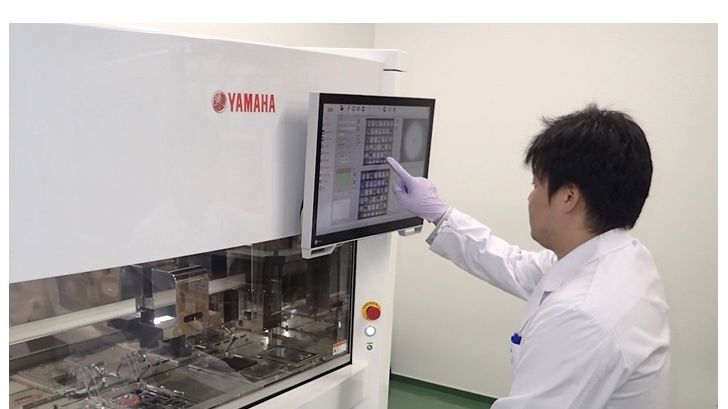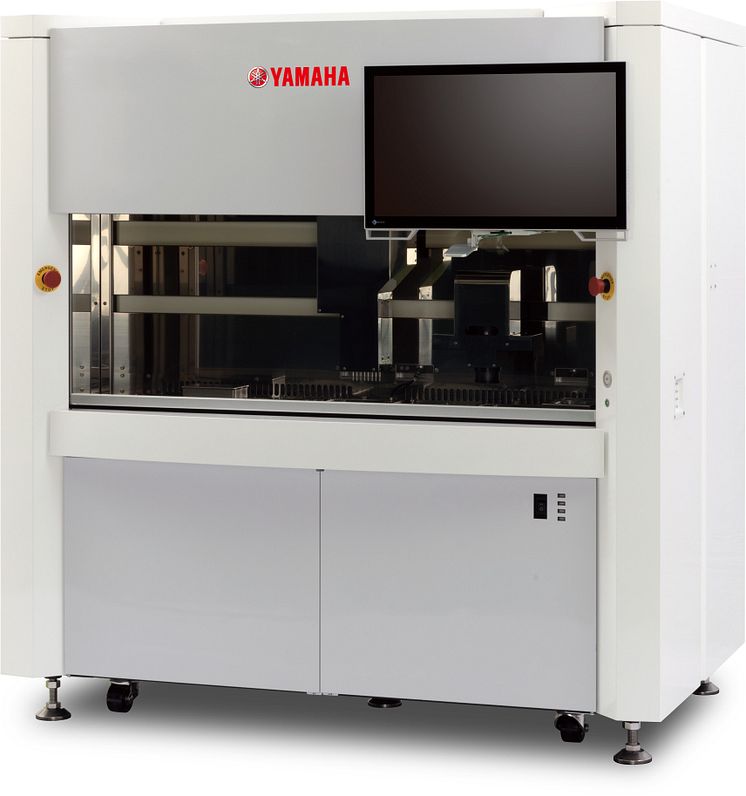
News -
Yamaha’s Biomedical Business -Yamaha Motor Monthly Newsletter(Oct.16, 2017 No.58)-
In 1955, the motorcycle business of Nippon Gakki Co., Ltd. (today’s Yamaha Corporation) was spun off to establish Yamaha Motor Co., Ltd. Shortly after, the company entered the marine industry, mainly offering outboard motors and boats. The core competencies for creating these products—small-engine and chassis/hull technologies—were then put to use in creating new products, thereby diversifying our business portfolio.
At the same time, Yamaha Motor succeeded in developing industrial robots to help automate its own production lines and eventually commercialized them as a new line of business. From there, Yamaha enhanced its electronic control technologies, helping the company develop new products that went beyond category boundaries as well as pioneer new businesses.
One of the newest examples of this is the CELL HANDLER™ announced in September 2017. It takes Yamaha’s surface mounter technology for producing printed circuit boards and adapts it to suit the needs of the biomedical sector, and this is the first Yamaha entry of its kind in the field. In this issue, we present an outline of this revolutionary device and its exciting prospects for the future.
*The CELL HANDLER™ is for research use only and is not for use in diagnostic or therapeutic procedures.
*As of October 13, 2017, this model is commercially available only in Japan.

Concept: Automate an Arduous, Time-Consuming Process
Yamaha’s CELL HANDLER™ contributes to improving the throughput of the screening process for creating new cancer drugs and the like, the most labor-intensive and time-consuming part of the development process.
The term “screening” refers to the process of repeated testing to gradually narrow down and isolate agents with potential pharmaceutical efficacy from among millions of chemical compounds. Cells taken from cancerous tissue are placed on separate culture plates and a different chemical compound is added to each specimen to observe what effect it has on the cancerous cell (aggregate). For the sake of handling ease, cost and time efficiency, the conventional screening process relied on large numbers of flat-dish (2D) cell cultures broken down into cell lines.
However, one issue is that these cell lines take on characteristics completely different from those in a living organism, so a potential drug still has to be tested on mice or the like before it can be used in clinical tests on human patients, and the success rate in this process is very low. To solve this problem, it is important to use aggregate cells from 3D cultures with characteristics similar to those in a living organism, but these cells in the culture solution are extremely small and fragile, making them very difficult to handle. Furthermore, the picking and placing has typically been done by hand, making it extremely time consuming and costly, thus limiting its use.
So, Yamaha chose to specialize in handling these aggregate cells. The CELL HANDLER™ uses a pipette (dropper tube) to pick up aggregate cells scientists have tested and deemed appropriate for research under a microscope, and then transfers them one-by-one to the finely divided wells of a microplate. At the same time, it also creates a digital image of each transferred cell and records the data, thus automating the entire process with high speed and precision.
Technological Development: Switching from Chips to Cells
The event that triggered the device’s development project was an idea contest for new businesses held in 2010 by the IM Business Unit, the department that designs and manufactures Yamaha’s industrial robots used on assembly lines for electronic devices, etc., and the Yamaha surface mounters used for producing printed circuit boards.
At the time, there was a lot of attention on medical research and business stemming from discoveries of methods for producing iPS cells, and one of the ideas submitted to the contest was for finding a way to apply the IM Business Unit’s unique technologies in the medical field to help save lives.
From this compelling proposal, the spotlight fell on the potential uses of Yamaha’s surface mounter technology, capable of moving a nozzle-mounted head along XY-coordinates with high speed and precision to pick up super-small electronic chips (less than 0.4 mm in size) and place them on the designated spot on a circuit board with a margin of error of ±0.05 mm. The idea was polished from there to essentially swap electronic chips for cells and circuit boards for microplates in order to mechanize and automate the handling of aggregate cells that could previously only be done by hand.
“However, the aggregate cells this involves are smaller than even super-small electronic chips, only about one-tenth to one-third the size,” says the General Manager of the Medical Device Business Development Division at Yamaha’s New Business Development Center. “What’s more, the task of picking out cells suitable for a given experiment from among numerous aggregate cells floating around in the culture solution and then precisely but gently picking up and transferring them without damage proved to be very difficult even for the most precise machinery,” he concludes.
To tackle this problem, Yamaha Motor exclusively developed its Precision Chamber™. Arranged in a grid format, the cell aggregates sink to the bottom of the grid of evenly spaced trough squares, allowing them to be picked up one by one just like picking and placing electronic chips from a supply pallet. Researchers are able to view and assess the aggregate cells in the chamber with digital images and then select ones that are suitable for the given experiment with a touchscreen. The artificial intelligence (AI) built into the CELL HANDLER™ enables it to learn the researcher’s selection standards so that the selection process can also eventually be done automatically. Then, in order to gently pick up the aggregate cells lined up in the chamber grid, Yamaha developed the Precision Tip™. Structured like a high-precision syringe, eight of these tips are fitted to a high-speed, high-precision head to gently suck up a cell aggregate from one square of the grid along with the culture solution and transfer it to a well of a microplate. One microplate is finely divided into 384 cell-receiving wells, so while manually picking cells one by one with a pipette and dropping them into the plate wells is a difficult task in itself, the CELL HANDLER™ is able to use all eight Precision Tips™ simultaneously to complete the task in an instant.
In the 48 repetitions of this pick and transfer process to fill all 384 wells of the microplate, the CELL HANDLER™ takes a photo image of the plate that clearly shows the shape and color of all the cells, and then calculates the surface area, etc., of each before compiling all the information into readable data. The CELL HANDLER™ completes this entire process—from cell selection to the final image and data processing—in less than 30 minutes with over 99% accuracy. “When the same process is done manually, the wells of a 384-well microplate are too small, so researchers are limited to a 96-well plate, which means that the process has to be repeated four times to get the same number of samples. In comparing the time required, the CELL HANDLER™ reduces the necessary time to less than one-fifteenth that,” says the General Manager.
Great Expectations: From This First Step to the Future
In developing the CELL HANDLER™, the first prototype was completed in 2013 and Yamaha then asked medical institutions in Japan and overseas to evaluate it. From the following year, work began on raising the reliability of a high-throughput model while also undertaking joint research with famed universities and research institutions in the areas of cancer treatment, etc., in order to explore business possibilities for adaptation for use in drug development and regenerative medicine.
Then in August 2017, the first CELL HANDLER™ was delivered to Fukushima Medical University. Since then, Yamaha has made various approaches to institutions with the goal of selling five units a year. For the time being, the CELL HANDLER™ will be primarily aimed at assisting drug development. This is because in the development process for creating new drugs, using aggregate cells increases the overall success rate, and if the throughput for screening can be increased, it brings big benefits in terms of productivity and cost reduction.
And that’s not all. “The CELL HANDLER™ answers the hopes of scientists wanting to conduct more efficient tests using cells with conditions closer to the living organism. We intend to explore other possibilities for its use in a wider range of areas such as toxicity testing for new drugs and cell panel testing in cancer research, so that we can offer other new solutions,” concludes the General Manager.
According to Guinness World Records, the oldest person in the world as of September 2017 is 117 years old and the record for the longest-lived human ever stretches to 122 years. But even in Japan, which boast the highest average life expectancy in the world, one in four men and one in six women dies of cancer. Of course, there are a number of other life-threatening diseases in the world that are difficult to treat, and there are also many people with a variety of different disabilities. What Yamaha Motor hopes for in entering this new venture in the medical field is to try to contribute in any way toward solving the problems the medical world faces today.

| The main job of the CELL HANDLER™ is to automate the selection, picking and transfer of aggregate cells that until now had to be done by hand. |


